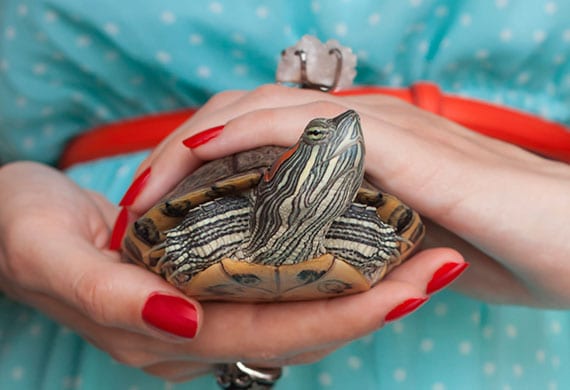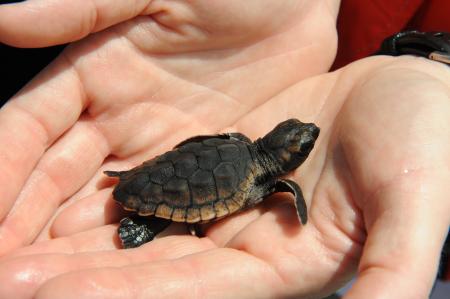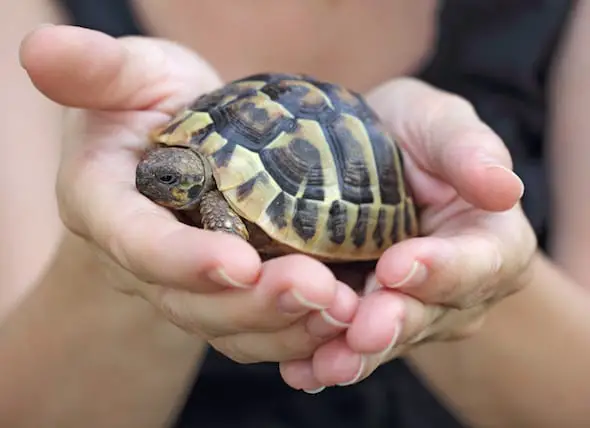Turtles are very popular to keep as pets, and they can be the perfect match for you, especially if you are looking for a pet that is fascinating to look at and appreciate. Turtles can be amazing for families that have grade school-aged kids and older, but it might not be a good fit for families who still have very young kids. This is because turtles have specific caring requirements that you should not forget. Here are some important things that you should know about caring for turtles.
What Are Turtles Afraid Of?

Many turtles are known for their ability to retract to their shells whenever they are feeling threatened and are seeking protection. Turtles are usually afraid of predatory animals that seek to use them as food items. The most common animal predators for turtles are:
- Birds – Turtles can become victims of bearded vultures, which fly above the ground to take the turtles from large rocks, boulders, and rocky grounds. These vultures will keep on attempting this if the shell of the turtles does not break after their first attempt. Aside from vultures, the crows, herons, seagulls, and ravens also prey on turtles.
- Carnivorous Mammals – There are numerous mammals that prey on turtles. For example, raccoons, coyotes, foxes, and domestic dogs snatch these turtles and carry them to an area where they can consume their prey without being disturbed. Occasionally, domestic cats, ferrets, skunks, opossums, and weasels can also kill young turtles if given a chance.
- Other Reptiles and Amphibians – Some large frogs also attempt to eat small freshwater turtles in the absence of more suitable prey. The other species that turtles are scared of are alligators and Nile monitors.
What If You Have A Turtle That Acts Like It Is Scared Of You?

Many turtle owners believe that their turtles are scared of them, mainly because they hide whenever they try to approach their turtles. Turtles are usually shy, not scared, and this is not a personality trait. Your pet is just getting used to having you around. There are many ways that you can get your pet turtle to come out of its shell. Here are some things that you can do:
1. Observe your pet regularly.
Regular observation is essential because it will help you be guided on what to do to ensure that your pet turtle associates positive things with you. Try to determine where your turtle is feeling comfortable when it is inside its cage.
Observe what things scare your pet and determine when your turtle feels playful and active. While you watch your turtle, you can make your presence known and stand near your pet’s cage. This practice will allow the turtle to get used to having you around and not scared of sensing your presence.
When you are with your pet, remove to not move too sudden so that you will not scare your pet away. Moving gently and calmly is the safest bet to ensure that your turtles will not be stunned with some rapid movements. While you are standing in front of your turtle’s enclosure, make slow movements and do not act too much.
2. Let your turtle associate you with food.
Food is always associated with animals as a positive thing. Therefore, turtle owners must make the most of using food to develop a wonderful relationship with your pet turtle. You can also establish a routine by feeding your turtle at the same time each day. You can start by placing some food inside the turtle’s enclosure and observe your pet turtle while it eats.
You should make slow movements so that you can let your turtle know about your presence without disturbing its feeding routine. Then, you can also gradually start to begin to attempt to feed your turtle by hand. You can try holding a piece of lettuce, or any type of vegetable, about 6 inches from your pet, and patiently wait until your turtle comes closer to eat from your hand.
After this, if you still observe that your pet turtle remains in a shy state of mind, you should consider switching from vegetables to live animals like crickets and worms so that the turtle can be engaged.
3. Learn about petting your turtle.
Lots of turtles enjoy physical petting, but accepting this will still depend on being acclimated to having humans around them. You can work on hand feeding your turtles and master this act until you feel comfortable enough to be in your presence.
After your pet turtle gets used to regular feeding, you can lightly touch the head and neck of your turtle while it eats. If the turtle retracts, you should wait and stop until a nice level of comfort is regained. You should also pet your turtle on a regular basis so that it will recognize your slight touches as a positive action, and it will reduce its shyness whenever it is around humans.
4. Establish a safe zone for your pet turtle.
Make sure that you consider that sometimes, animals need some space for them to breathe, too. Create a safe zone where your turtle can hide if it wants and make sure that you do not enter this safe zone. You can find some half logs and other home accessories in pet stores, and they can serve as your pet’s comfort zone. Because of the availability of a hiding place, your pet turtle will have a way to reduce stress. In case of a threat, your turtle would know that it has someplace to run to.
5. Minimize your turtle’s interactions.
By nature, turtles are not really social, to begin with. Therefore, even when you have established a relationship with your pet, limit your interactions so your turtle will not tire out. If you see the turtle hiding or resting, do not harass your pet. Always wait for your pet’s cues before you interact with the animal.
How to Pet & Handle A Scared Turtle

- Approach your turtle from the front. If the turtle is unable to see you and your hand suddenly appears, it can bite you when it gets frightened.
- Place your turtle in a low and flat surface. Your pet will be more likely to be receptive to your actions if they feel safe and secure.
- Start petting at the top of your turtle’s head. Run your finger gently through your turtle’s head, but be careful and remember that you must avoid your turtle’s eyes and nose.
- Pet the cheeks and chin of your turtle using your fingers and giving gentle touches.
- Massage your turtle’s neck once you notice that it is finally relaxed when it is around you.
- You can also pet your turtle’s shell because their shells are capable of feeling. You should start by stroking your turtle’s shell in slow circles and run your fingers in a straight line along the length of its shell. As an alternative, you can also use a toothbrush or a small brush along the top of your turtle’s shell.
- Alternatively, you can also allow your turtle to enjoy some lap time by allowing your pet turtle to crawl all over you and sit on your lap. Just make sure to watch it carefully so that it will not fall off.
- Be cautious in lifting up your turtle because it might urinate on you.
Other Turtle Handling Tips

Always be patient with your turtle. Just because you acquired a captive-bred domesticated turtle, it does not necessarily mean that it would be used to being handled.
- Handle your pet with care and avoid picking them up unless it is necessary.
- To handle a small turtle, place your open palm under its bottom shell and make sure that its legs can touch your hand.
- Lift the turtles up from its backside and not through its front. Turtles are unpredictable, and lifting the turtle from its front will give the turtle an opportunity to bite you.
- Do not place your turtle upon the edge of a high surface. Doing so might lead to injuries for your pets as they are not readily aware of their environment.
- As a rule of thumb, it is never wise to touch the claws and legs of your pet turtle.
- Never forget that turtles are not invincible, and their shells can still be scratched, damaged, break, and acquire infections.
- Make sure that your turtle receives the right temperature because cold turtles are more likely to shy away compared to warm ones.
- If your turtle is not in the mood to communicate with humans, you might be witnessing some physical signs. It can include hissing, biting, snapping, withdrawing into the shell, and sitting motionless with their mouths open.
Always practice the right hygiene when you interact with your turtle. There might be diseases on their skin that can be transmissible to humans.



